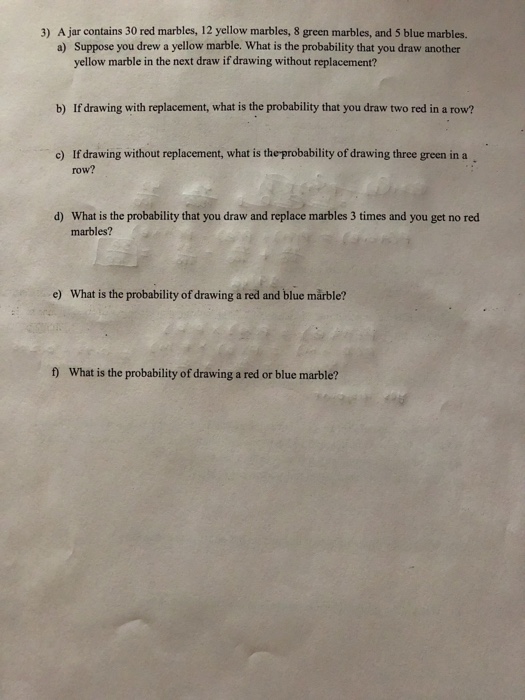Suppose a jar contains 5 red marbles and 12 blue marbles.
A jar contains 6 red marbles.
A jar contains 6 red marbles and 10 blur marbles all of equal size.
B find probabilities for p bb p br p rb p ww p at least one red p exactly one red 3.
Solution for a jar contains 6 red marbles numbered 1 to 6 and 12 blue marbles numbered 1 to 12.
Enter your answer in the box to the nearest percent.
There are 55 marbles 25 of which are not red p getting a color other than red p 25 55 455 probability of this happening 3 times in a row is.
If dominic were to randomly select 1 marble without replacement and then select another marble from the jar what would be the probability of selecting 2 red marbles from the jar.
A jar contains 6 red marbles numbered 1 to 6 and 9 blue marbles numbered 1 to 9.
A glass jar contains 6 red 5 green 4 blue and 5 yellow marbles of same size.
A the marble is red b the marble is red or odd numbered c the marble is blue and even numbered answer by ikleyn 33701 show source.
A jar contains 12 red marbles numbered 1 to 12 and 6 blue marbles numbered 1 to 6.
Hari takes out a marble from the jar at random.
Find the probability of the given event.
A a marble is chosen at random.
What is the probability that the chosen marble is of red colour.
Asked by lori on april 8 2012.
4 red 6 white and 10 blue.
Two marbles are drawn without replacement from a jar containing 4 black and 6 white marbles.
A marble is drawn at random from the jar.
Probability examples a jar contains 30 red marbles 12 yellow marbles 8 green marbles and 5 blue marbles what is the probability that you draw and replace marbles 3 times and you get no red marbles.
A bag contains 6 red marbles 3 white marbles and 7 blue.
A jar contained 6 red marbles 10 green marbles and 8 blue marbles.
A marble is drawn at random from the jar.
The table shows the results after 60 trials.
A jar contains 20 marbles.
A marble was selected at random the color was recorded and the marble was placed back in the jar.
Two marbles are drawn without replacement.
What was the relative frequency of selecting a red marble.
If you reach in the jar and pull out 2 marbles at random at the same time find the probability that both are red 17 total marbles the 1st pick is 5 17 then 2nd is 4 16 the product is 5 68 makes no difference if you take 2 at a time or 2 different choices without.
If you remove marbles one at a time randomly what is the minimum number that must be removed to be certain that you have at least 2 marbles of each colour.

